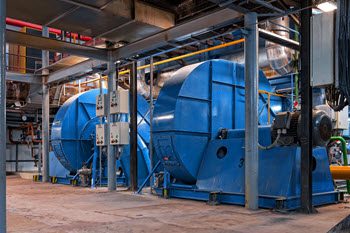Winter can be a challenging season for businesses, especially those in regions prone to sub-freezing temperatures and severe weather conditions. Power outages during winter storms or due to increased demand and stressed electrical systems can disrupt operations, leading to significant losses. Having a commercial backup generator is essential, but it’s equally important to ensure that it’s winter-ready. In this article, we present a recommended checklist and valuable suggestions to help ensure your commercial backup generator is well-prepared for peak performance when it’s needed most.
What Sets Apart a Commercial Generator from a Commercial Backup Generator?
Commercial Generator
* Primary power source for continuous electricity supply.
* Used in critical facilities and businesses with no tolerance for downtime.
* Matches facility load demands and often operates continuously.
* Requires regular maintenance due to continuous use.
* Higher initial investment cost.
Commercial Backup Generator:
* Secondary power source for emergency use.
* Provides power during brief outages to essential functions.
* May require manual startup or automatic activation.
* Requires less frequent maintenance.
* Cost-effective solution for managing short interruptions in power supply
Winter Generator Starting Issues
Before delving into the checklist, it’s crucial to understand why commercial generators may struggle in winter conditions. Several factors contribute to this:
Cold Oil: Low temperatures cause oil to thicken, making it harder to flow, potentially triggering low oil sensors that can prevent the generator from starting.
Cold Battery: Cold weather reduces a battery’s capacity, making it less effective in starting the generator, especially if the battery is only partially charged.
Cold Electronics: Electronic control panels may fail to function correctly in extremely cold conditions.
Air Blockage: Accumulation of snow, sleet, or ice in the air intake and exhaust ports can hinder proper airflow, affecting generator performance.
Exposure: Generators placed outdoors in sub-zero temperatures can struggle to operate efficiently, particularly natural gas generators.
Wet Stacking: Incomplete fuel combustion can lead to carbon soot buildup in exhaust pipes, affecting generator performance.
Fuel Gelling: In extremely cold conditions, diesel fuel can gel and become viscous, impeding the flow of fuel to the generator’s engine. This can result in difficulty starting the generator or even engine damage if not addressed properly.
Fuel Quality: The quality of fuel used in the generator can significantly impact its performance in cold weather. Poor-quality fuel or fuel contaminated with water can lead to starting problems and reduced generator efficiency during winter months.
Cold Fuel Lines: Sub-freezing temperatures can cause fuel lines to contract and become brittle, increasing the risk of cracks or leaks that can disrupt fuel flow to the generator.
Frozen Fuel Filters: Fuel filters can freeze in cold weather, restricting fuel flow and leading to starting difficulties.
Coolant Freeze: Inadequate or improper coolant mixtures can lead to freezing within the generator’s cooling system, potentially causing damage and preventing the engine from starting.
Lubrication Challenges: Cold temperatures can affect the viscosity of lubricating oils, making it essential to use winter-grade oil to ensure proper engine lubrication and starting.
Ignition System Issues: Extremely cold conditions can strain the generator’s ignition system, potentially causing problems with spark plugs and ignition components.
Temperature-Sensitive Sensors: Some generators rely on temperature-sensitive sensors for various functions. Extreme cold can affect the accuracy and functionality of these sensors, potentially impacting generator performance.
Exhaust System Freezing: The accumulation of ice and snow in the exhaust system can impede the discharge of exhaust gases, affecting engine performance and starting.
Preparing Your Generator for Winter
Now that we understand the challenges let’s explore the checklist to winterize your commercial backup generator:
Inspect and Clean Your Generator
Clear Debris
Clear debris from air vents and surrounding areas to ensure proper airflow and prevent blockages that can affect the generator’s performance.
Check for Loose Wires, Corrosion, and Compromised Parts
Thoroughly inspect the generator for loose wires, corrosion, and compromised parts, addressing any issues to maintain the generator’s electrical integrity.
Perform Visual Inspections, Fluid Level Checks, and Hose Inspections
Conduct regular visual inspections, fluid level checks, and hose inspections to identify and rectify any anomalies that may affect the generator’s functionality and reliability.
Inspect Exhaust System
Examine the exhaust system for obstructions or damage to ensure the proper venting of exhaust gases, preventing potential issues with emissions and ventilation.
Check Belts and Pulleys
Inspect belts and pulleys for wear and proper tension to prevent slippage and maintain efficient generator operation.
Tighten Electrical Connections
Verify the tightness of all electrical connections to prevent loose or corroded wires, ensuring uninterrupted electrical flow.
Inspect Control Panels
Examine the control panels for signs of damage or malfunction, ensuring that all indicators and controls are in working order.
Evaluate Fuel Lines
Inspect fuel lines for leaks, cracks, or damage, and promptly replace any compromised sections to prevent fuel system issues.
Check Coolant Levels
Monitor and maintain proper coolant levels to prevent overheating and ensure the generator operates within safe temperature limits.
Preventing Winter Stagnation: Why You Should Run Your Generator
Running your generator on a weekly basis during winter is crucial for several reasons, ensuring it remains in optimal condition when needed most.
Run the Generator Weekly
Schedule weekly generator runs to lubricate moving parts, preventing rust and ensuring smooth operation. Regular operation also helps maintain seals, preventing leaks and maintaining the generator’s integrity.
Conduct Visual Inspections
While running the generator, perform thorough visual inspections to detect any signs of wear, damage, or irregularities. Visual inspections are essential for identifying issues early and addressing them promptly.
Prevent *Wet Stacking
Diesel generators are susceptible to a condition known as “wet stacking” when operated at less than 60% of their rated output for extended periods. Wet stacking occurs due to incomplete combustion, leading to the buildup of unburned fuel and soot in the exhaust system. To prevent wet stacking and maintain optimal generator performance, it is essential to operate diesel generators at more than 60% of their rated output, ensuring proper combustion and preventing carbon buildup in the exhaust system.
Preventing Cold-Start Blues: The Role of Engine Block Heaters
Engine block heaters play a vital role in ensuring your generator starts reliably in cold weather conditions. Here’s what you need to know:
Install an Engine Block Heater
Engine block heaters are essential components for cold-weather generator operation. These heaters keep the engine oil warm during idle periods, preventing it from thickening in low temperatures. By installing an engine block heater, you ensure that your generator is ready to start promptly, even in frigid conditions.
Ensure Engine Coolant Temperature
To meet safety regulations and maintain optimal generator performance, it’s crucial to ensure that the engine coolant temperature remains within the manufacturer-recommended range. This range can vary depending on the generator’s model and specifications but typically falls between 100°F to 120°F. Proper engine coolant temperature helps prevent freezing and ensures that the generator can operate safely and efficiently, especially in winter conditions.
Change to a Winter-Grade Oil
The type of oil used in your generator can significantly impact its performance during the winter season. Here’s what you need to consider:
Switch to Winter-Grade Oil
When preparing your generator for winter, it’s advisable to switch to a winter-grade oil. Winter-grade oil is formulated to reduce oil viscosity in cold temperatures, making it easier for the engine to start. This adjustment ensures that the oil flows smoothly even in sub-freezing conditions, enhancing your generator’s cold-weather performance.
Consider Switching Back to Regular Oil
As temperatures begin to rise with the arrival of spring and milder weather, it’s worth considering switching back to your regular oil. Winter-grade oil is specifically designed for cold weather, and using it in warmer conditions may not provide the same level of lubrication and protection as your standard oil. Be sure to follow the manufacturer’s recommendations for oil changes based on seasonal variations in temperature.
Maintain Battery Warmth and Ensure Full Charge
Maintaining warmth and ensuring a full charge of your lead-acid battery is crucial to prevent capacity reduction in cold weather conditions. Regularly charging the battery helps retain its effectiveness in colder temperatures. Additionally, using a thermostatically controlled warming blanket is recommended to protect the battery from freezing temperatures, ensuring it remains operational even in frigid conditions.
Battling the Cold: Protecting Openings from Precipitation
Safeguarding your generator from winter precipitation is crucial for its uninterrupted performance. Here’s what you need to do:
Install Snow Hoods or Louvers
To prevent horizontal precipitation such as snow, sleet, or freezing rain from obstructing airflow, consider installing snow hoods or louvers on the air intake ports of your generator. These protective additions ensure that your generator can breathe freely even in challenging winter conditions, maintaining optimal airflow for efficient operation.
Cover the Generator or Enclosure
Shield your generator from vertical precipitation, including rain and snowfall, by covering the generator or its enclosure. A proper cover helps prevent moisture from seeping into sensitive components and safeguards against potential damage caused by exposure to winter weather. Ensure that the cover is secure and provides adequate protection, especially during heavy precipitation events.
Your Generator’s Winter Guidebook: The Owner’s Manual
Your generator’s owner’s manual is your go-to resource for winterizing your equipment effectively. Here’s how you should utilize it:
Refer to the Manufacturer’s Instructions
The manufacturer’s instructions provided in your generator’s owner’s manual are a valuable resource for winter preparation and maintenance. These instructions are tailored to your specific generator model and offer essential guidance on how to ensure reliable winter operation. By referring to the manual, you gain insights into the manufacturer’s recommended winterization procedures, helping you make informed decisions.
Follow the Manual for Warranty Compliance
Adhering to the guidelines outlined in your generator’s owner’s manual is not only essential for proper care but also for warranty compliance. Deviating from the recommended procedures may void warranties and result in costly repairs or replacements down the line. Make sure to follow the manual diligently to safeguard your investment and maintain your generator’s peak performance throughout the winter season.
The Role of Preventive Maintenance in Winter Preparedness
Preventive maintenance involves systematically inspecting, servicing, and maintaining equipment to prevent potential breakdowns and failures. In the context of commercial backup generators, it plays a pivotal role in ensuring these vital assets operate optimally throughout the winter months.
The Benefits of CMMS for Preventive Maintenance
A CMMS is a digital solution that empowers businesses to streamline their maintenance processes, including preventive maintenance. Here are the key advantages of using a CMMS for winter generator maintenance:
Automated Scheduling: CMMS software allows you to schedule routine maintenance tasks for your generator, including winter-specific checks, well in advance. Automated reminders ensure that these tasks are never overlooked, reducing the risk of neglecting essential maintenance.
Detailed Maintenance Records: CMMS systems maintain a comprehensive history of all maintenance activities performed on your generator. This detailed record-keeping aids in tracking performance, identifying recurring issues and making data-driven decisions for future maintenance.
Inventory Management: CMMS platforms often include inventory management features, ensuring you have the necessary spare parts and supplies readily available for winter maintenance. This minimizes downtime due to waiting for critical components.
Cost Efficiency: By conducting regular preventive maintenance and addressing minor issues promptly, you can significantly reduce the risk of costly breakdowns and emergency repairs. This proactive approach ultimately saves your business time and money.
Compliance and Reporting: CMMS software helps you maintain compliance with industry regulations and manufacturer guidelines for generator maintenance. It also simplifies the generation of detailed reports for auditing and documentation purposes.
Final Thoughts
In the challenging winter months, the significance of preventive maintenance and comprehensive checklists, supported by eWorkOrders CMMS for your commercial backup generator, cannot be overstated. These practices, combined with a robust CMMS system, are not mere precautions but strategic investments in the resilience and continuity of your business. By diligently following preventive maintenance schedules and adhering to comprehensive checklists within the eWorkOrders CMMS platform, you ensure that your generator remains dependable even in the harshest conditions. This approach minimizes the risk of unexpected breakdowns during winter storms or extreme temperatures, saving you costs, ensuring worker comfort and safety, and upholding compliance with industry regulations. Moreover, it safeguards your assets, sustains business continuity, protects your reputation, and contributes to environmental responsibility. Preventive maintenance and eWorkOrders CMMS-powered checklists provide the peace of mind that your generator is well-prepared for winter, allowing you to focus on your core business activities without constant worry about potential power disruptions.
Other Resources
Importance Of Industrial Generator Maintenance
Maintenance Terms & Definitions Glossary
See What Our Customers Are Saying
Disclaimer:
The recommendations provided in this article serve as general guidelines for preparing your commercial backup generator for winter. While these suggestions are intended to assist and inform, it is crucial to remember that specific maintenance and preparation requirements may vary based on the make and model of your generator. Therefore, it is strongly advisable to consult with your generator manufacturer or a qualified professional to ensure that your generator is adequately prepared for winter conditions. Your generator manufacturer or authorized service provider can offer tailored advice and guidance that aligns with your generator’s specifications and maintenance requirements. By following manufacturer-recommended procedures and seeking expert advice, which can be efficiently managed with eWorkOrders CMMS, you can enhance the reliability and performance of your commercial backup generator during the winter season.



